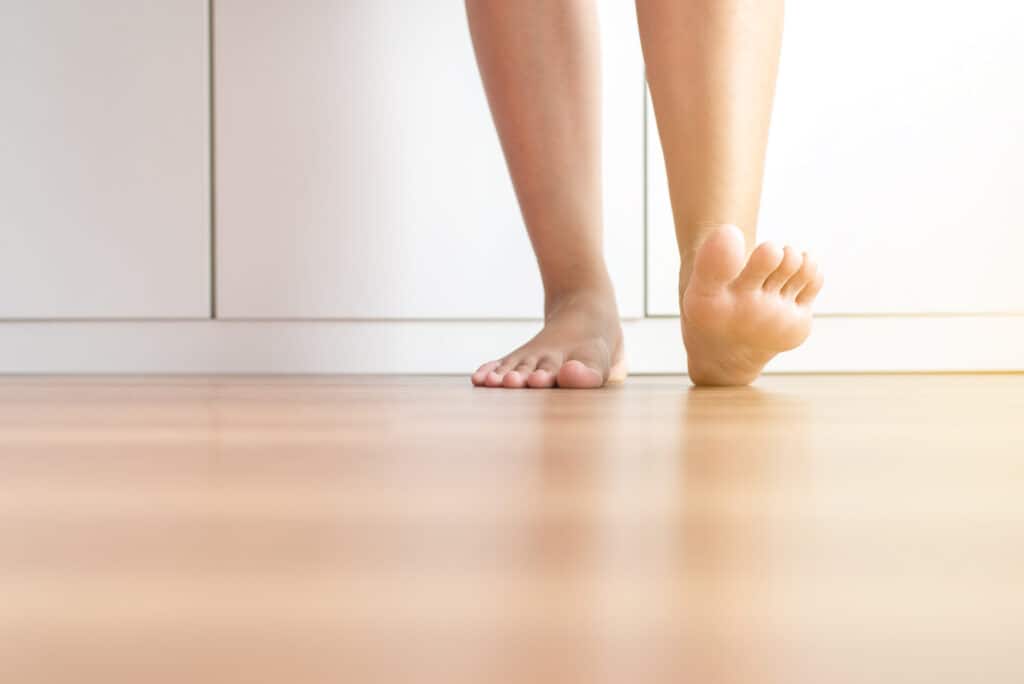‘You are only as a strong as your weakest link.” We have all heard this statement before. But what does it really mean? One researcher summarized it as “the idea that functionality results from the efficiency of an integrated system, like a gear train in which each gear corresponds to one physical capacity. In this system, if one gear fails, the function of the whole system is compromised, thus demonstrating the importance of the integrated and balanced development of different physical capacities.”
With this in mind, let’s look at the importance of the feet. In terms of injury, “if the feet go …you go.” If you have ever had a foot injury from an ankle sprain to gout to plantar fasciitis, you know how debilitating it can be. Foot injuries such a stress fracture or an achilles tendon tear, can impact your training and activities of daily living. Prevention is the best medicine when it comes to the feet. Add a few exercises into your dynamic warm-up or exercise routine to keep the feet strong and supple.
Here are a few simple-to-do exercises that can be performed anywhere to help avoid potential foot injuries.
1. Tennis Ball Heel Raises
It is important to keep the soles of the feet healthy. Many people end up getting plantar fasciitis at some point. To help prevent this try doing calf raises while squeezing a tennis ball between the heels. You can stand on a weight plate of a step with the heel unsupported. This will help to strengthen calf muscle but also a small muscle known as the posterior tibialis anterior. This muscle acts to plantar flex and invert the foot as well as support the medial arch. It is also important for stabilizing the lower leg. The posterior tibial tendon attaches the calf muscle to the bones on the inside of the foot. Build up to 3 sets of 12-15 repetitions. Perform them barefoot if possible.
2. Roll Out the Feet
While sitting at your desk or when watching TV use a golf ball to roll out the bottom of both feet. It works wonders and is a great tool for releasing any tight fascia. If you don’t have a golf ball substitute with a lacrosse or tennis ball.
3. Toe Flexion/Extension
Start in a standing position with the feet hip-width apart. Move the right foot forward about 6-8 inches in front of the left foot. Now, focus on pulling the toes up towards the nose (extension). As you return, push the toes and upper foot into the floor. That is one repetition. Perform 20 repetitions building up to 3 sets. Do this barefoot.
4 & 5. Ankle Dorsiflexion & Heel Walk
Start in a standing position with the feet shoulder-width apart. Raise your toes and then feet off the floor at the same time. You can also alternate between left and right if you want. Perform 20 repetitions x 3 sets. After each set, walk around on your heels for time or specific distance. These exercises with strengthen the front of the lower leg (tibialis anterior). This is the area where shin splints can occur. This is a great exercise for anyone, especially runners.
Final Thought
You ave been given 5 easy-to-do exercises that will help prevent foot injuries while keeping foot mechanics healthy. It is up to you what you end up doing and how much time you commit to. The last thing you want is to end up with one of the injuries mentioned earlier. Remember, prevention is the best medicine! Of you have access to a massage, gun the front/back of the lower leg a few times a week. If you do not have a therapy gun use a tennis ball to roll out the area. Also, these five foot/ankle exercises can be done in a circuit fashion. Meaning, complete each one for one set in order from one to number five, and repeat for three rounds.
Stay Strong Together
Try the award-winning Jefit app which comes equipped with a customizable workout planner and training log. The app also has ability to track data. It also offer audio cues, and has a feature to share workouts with friends. Take advantage of Jefit’s exercise database for your strength workouts. Visit our members-only Facebook group. Connect with like-minded people, share tips, and advice to help get closer to reaching your fitness goals.
- 4 Must-Have Exercises Backed by Science for a Full-Body Workout - April 14, 2025
- Best Warm-Up for Strength Training, Backed by Science - April 11, 2025
- 5 Proven Tips to Unlock Your Full Potential in the Gym - April 9, 2025
